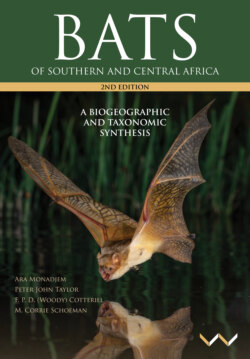Читать книгу Bats of Southern and Central Africa - Ara Monadjem - Страница 43
На сайте Литреса книга снята с продажи.
ECHOLOCATION
ОглавлениеThe majority of vertebrates rely on vision to perceive their environment. Even nocturnal predators such as owls and lions principally use their eyes to navigate and hunt. In contrast, most bats find food and avoid obstacles at night with great ease using an alternative sensory mechanism, called echolocation. Although usually associated with bats, other animals such as toothed whales, porpoises, some species of shrews and tenrecs, oilbirds, and several species of swiftlets also use echolocation.
Echolocating bats emit sound pulses and analyse the returning echoes to detect, characterise, and localise objects that reflect the impinging pulse as an echo (Fenton 1990, Schnitzler and Kalko 2001, Fenton et al. 2016) (Figure 35). Sound pulses are generated in the larynx (except in Rousettus species, which produce echolocation pulses by repeatedly clicking their tongue against the palate), and emitted through the mouth (e.g. Vespertilionidae, Miniopteridae, Cistugidae, Emballonuridae, and Molossidae) or nose (e.g. Rhinolophidae, Hipposideridae, Rhinonycteridae and Nycteridae). The ears, or pinnae, receive returning echoes, which are then funnelled and processed into the rest of the bat’s hearing system.
Figure 35. Rhinolophus capensis in pursuit of a moth. The dashed lines depict the echoes perceived by the hunting bat.
Not all vocalisations produced by bats are echolocation calls. For example, the audible squeaks bats make in their roosts, the calls that mother and young make to one another, or the calls flying bats make to defend their foraging territories, are not echolocation calls. Instead, these are usually referred to as social calls and are less well understood than echolocation calls.
The echolocation frequencies of most bat species are ultrasonic (i.e. above the range of human hearing), and peak echolocation frequencies (i.e. the frequencies with the highest intensity) usually fall within 20–60 kHz (Fenton 1990). This may be due to the frequency-dependent effects of atmospheric attenuation and target strength (Jones and Rydell 2004). In contrast, many social calls are audible to humans.
Echolocation coupled with flight enables bats to capture nocturnal flying insects in a variety of habitats. This ability probably explains how the radiation of bat species has manifested into the highest trophic diversity among mammals (Patterson et al. 2004, Roemer et al. 2019). Nevertheless, not all bats echolocate (e.g. fruit bats from the family Pteropodidae, except Rousettus species), nor do all echolocating bats use the same type of echolocation.
